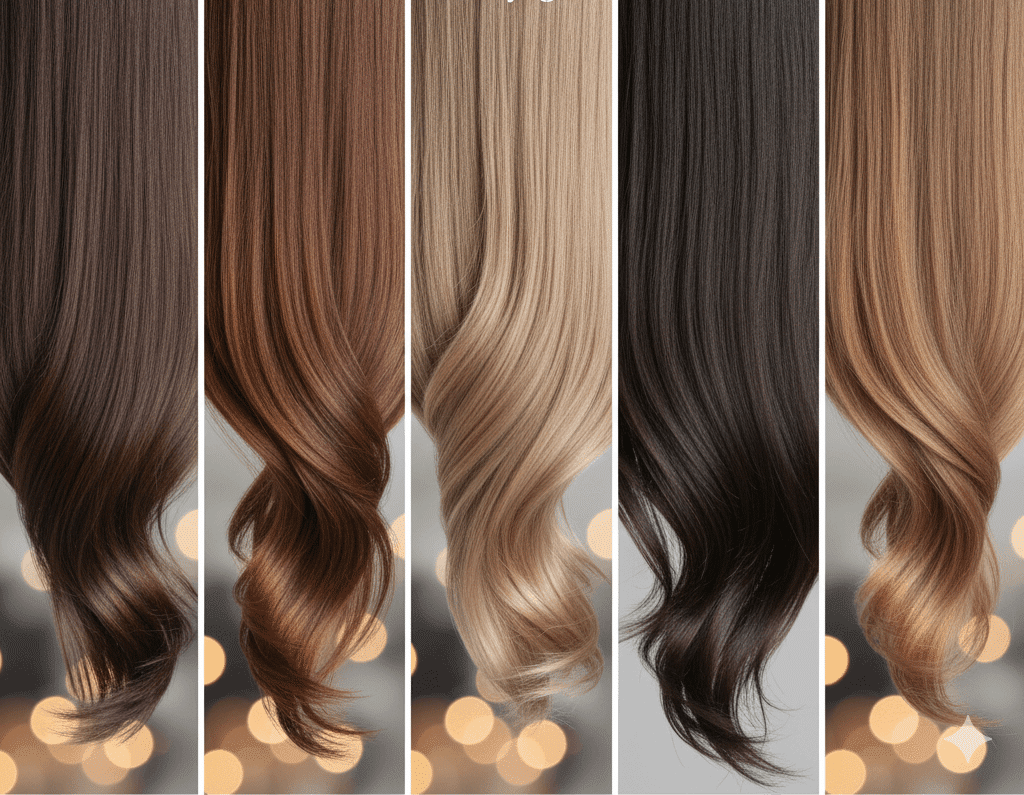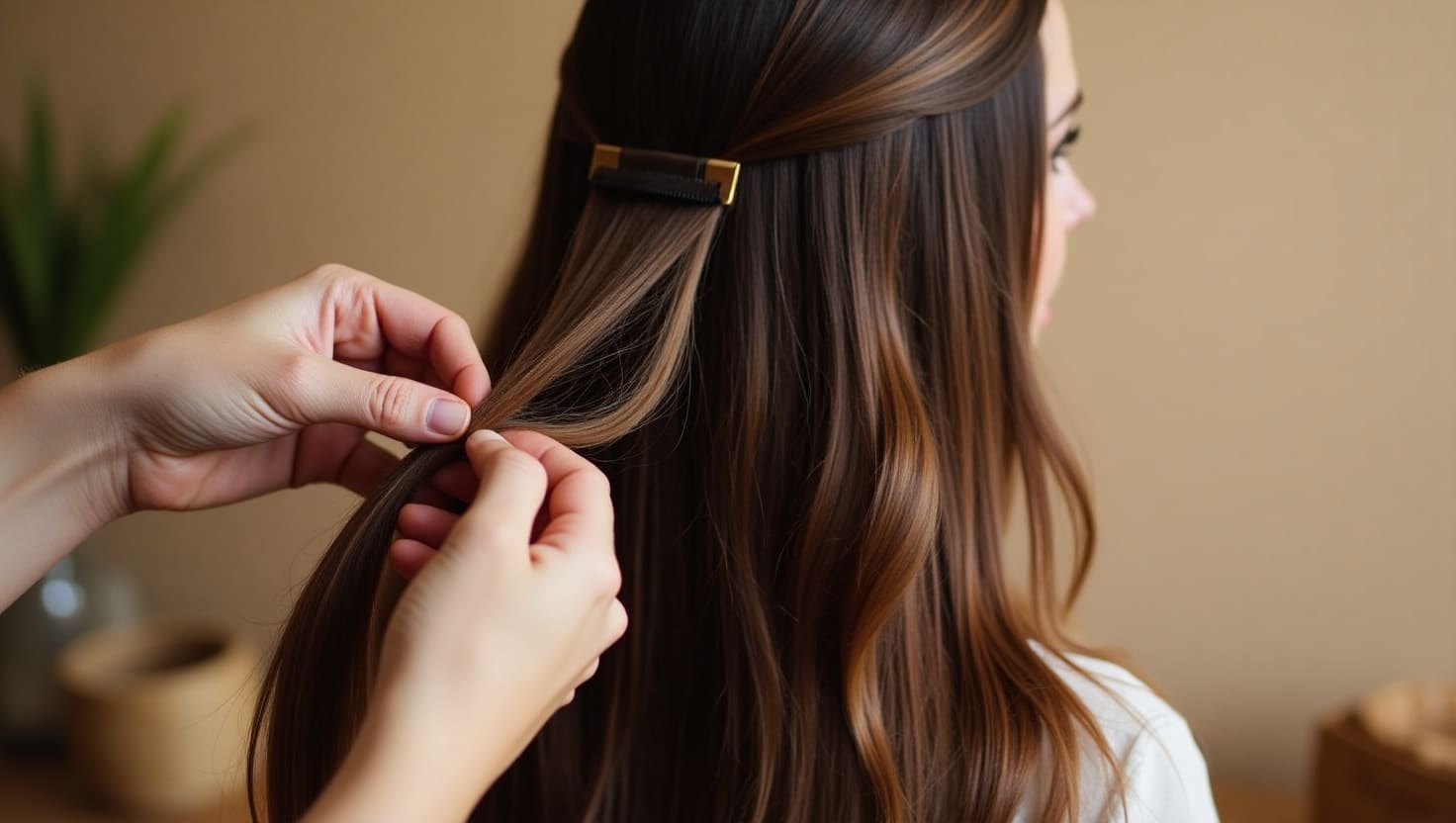Got thin hair yet still want to gain both volume and length? The best types of hair extensions for this purpose are the tape-in and halo ones.
Their brands are lightweight, less visible and very gentle on the fragile locks which gives the required effect and doesn’t cause any damage to them.
The tape-ins are virtually flat against your head and match your hair color perfectly, while the halos just fit your head without any harm and can be your quick saviors when you have no time for a style.
Avoid sew-in or fusion hairlogy as they may cause your hair to thin and eventually break. You will be able to realize an organic appearance with tape-ins or halos and at the same time practice good hair care.
1. Tape-In Extensions: The Perfect Choice for Thin Hair
When it comes to finding the best hair extensions for thin hair, tape-in extensions are a popular choice for several reasons:
These extensions are lightweight and flat, so they won’t weigh your hair down, giving you a beautifully natural look.
They cause minimal damage: Since you don’t need to use any harsh products, your hair stays healthy and strong.
They blend seamlessly: If you choose a color that matches your own, it’s nearly impossible to spot where they begin.
They’re reusable: With the right care, you can use them multiple times, making them a great investment.
2. Halo Extensions: Effortless and Damage-Free
For women with fine hair looking for an easy, no-damage solution, halo extensions are the way to go!
These extensions feature a clear wire that sits comfortably around your head, allowing your natural hair to flow freely without any clips or glue.
Your own hair is the star of the show, with no added pressure from extensions.
They’re super quick and easy to apply, making them perfect for styling at home.
Great for special occasions: Whether it’s a party, a photoshoot, or a night out, they’re ideal for adding a little extra flair.
While halo extensions may not last forever, their comfort and safety make them a top choice for those with sensitive scalps.
3. Clip-In Extensions: Use with Caution
Clip-ins can work for thin hair — but only if chosen and applied with care:
- Choose Lightweight Sets: Prefer 5- or 7-piece sets instead of 10-piece ones not to be able to lift the weight.
- Tease and Protect: Don’t be afraid to slightly backcomb the roots before attaching the clips. That will only make things worse.
- Use Sparingly: Don’t use daily. This applies to your hair in the rack, as well.
Clip-ins are best left for use when a special occasion priority instead of daily wear.
4. What to Avoid: Fusion, Sew-Ins, and Microlinks
Some of the methods which are trendy at the same time are not a good idea for thin hair:
- Fusion/Keratin Bonds: This method is also called hot and cold; the hair being attached has to be divided with heat, after which it gets attached to your hair through glue, etc. It is a disaster for fine hair as it breaks it.
- Sew-Ins: The hair section should be thick provided; even the only thing the actress had is too tight for its hair strands.
- Microlinks: Besides the fact that these kinds of extensions are proclaimed to be safe for the hair, metal beads are the ones damaging the hair.
Choosing the Right Hair Type and Texture
Once you’ve picked your hair extension method, it’s time to consider the type of hair used for those extensions:
Remy Human Hair: This is the gold standard! It’s human hair collected with the cuticles all aligned, which means you’re getting a top-notch product. This alignment helps prevent tangling, knotting, or matting, making it both durable and natural-looking.
Fine-Textured Extensions: Make sure to choose extensions that match the thickness of your own hair. And don’t forget about color! Your extensions should blend seamlessly with your natural hair.
Color Match: Always opt for a color that matches your roots or the overall shade of your hair. It’s all about finding that perfect tone that you can confidently stick with.
Interestingly, some brands cater specifically to those with thin hair, offering lighter wefts and gentle adhesive applications to ensure a comfortable fit.
Maintenance Tips for Thin Hair Extensions
Just as important as selecting the right extensions is taking care of them properly:
Opt for Sulfate-Free Shampoo: This will help keep those adhesive bonds strong and intact.
Be Gentle on Your Scalp: Use a loop or detangling brush to avoid putting too much stress on your roots.
Avoid Heavy Styling Products: These can weigh down both your natural hair and extensions, leaving them looking greasy and messy.
Schedule Regular Touch-Ups: Whether it’s for reinstallation or just a touch-up, keeping up with maintenance is key to preventing slippage and buildup from oils and sweat.
Final Thoughts: Comfort, Confidence, and Care
When it comes to extensions for thin hair, comfort and safety should come first. While it’s tempting to go for dramatic volume, the wrong choice can cause lasting damage. Opting for lightweight, non-invasive options like tape-ins or halos ensures you look fabulous and keep your natural hair healthy.
Invest in quality, consult with a pro, and give your hair the gentle treatment it deserves. With the right type of extensions, thin hair can be just as glamorous as any other — and maybe even more so.
FAQs About Best Hair Extensions for Thin Hair
Q: My hair is super thin, can I even use extensions?
A: Totally! You just gotta be smart about it. Heavy or tight extensions can hurt your hair, but lighter ones like tape-ins or halo extensions are way better. They won’t pull or damage your strands.
Q: What’s the deal with tape-in vs halo extensions? Which one’s better for thin hair?
A: Tape-ins stick on your hair for a few weeks and look really natural. Halos are like a headband with hair attached — you just pop them on when you want. If you want something to wear every day, tape-ins are the move. For special events or quick fixes, halos rock.
Q: Can I use clip-in extensions if my hair is thin?
A: You can, but be careful. Pick lighter clip-ins and don’t wear them all day every day. Clips can pull on your hair, so save them for fun occasions.
Q: Are there types of extensions I should skip?
A: Yup! Avoid fusion (keratin) bonds, sew-ins, and microlinks if your hair’s thin. They can be too heavy or use glue and heat that might mess up your hair.
Q: What kind of hair is best for extensions?
A: Go for Remy human hair — it looks real, lasts long, and blends well. Match the color and texture to your hair so no one can tell.
Q: How do I keep my extensions nice without hurting my thin hair?
A: Be gentle! Use shampoo without harsh chemicals, brush softly, don’t pile on heavy gels or sprays, and see a pro regularly if you have tape-ins.
Q: Will extensions actually make my thin hair look fuller?
A: For sure! The right ones add volume and length without wrecking your hair. Just pick the right style and care for them properly.





